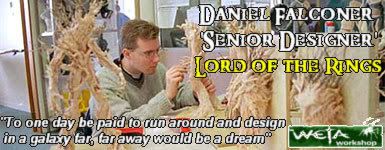
Daniel Falconer is one of a group of designers who joined Weta Workshop in 1996, shortly before The Lord of the Rings. He has a deep knowledge of Tolkien's Middle-earth, thanks to an avid interest in the books and associated materials, which frequently proved useful on the project. This lead to Daniel also being involved in writing copy for Weta's licensed collectible product from The Lord of the Rings, a role that has continued alongside his design responsibilities in the years that have followed.
Since The Lord of the Rings, Daniel has contributed design work for various projects including King Kong, The Lion, the Witch and the Wardrobe and Halo. In 2005 he collated and wrote copy for Weta's first book: 'The World of Kong, A Natural History of Skull Island', showcasing the illustrative work of the entire design department.
This interview took place in 2007 and premieres at this website.
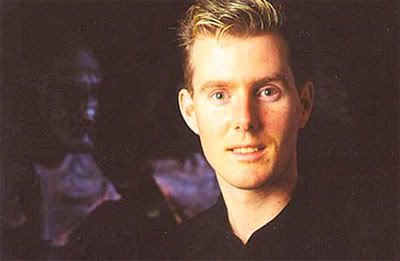
As an artist, what and who inspired you when you started out?
There were several sources of inspirations that I personally drew from when the task of designing Middle-earth was presented. Obviously Tolkien’s writings were the first source. I have long been a fan of these books and hoped and dreamed that I might one day have something to do with bringing them to the screen. Reading the books one can’t help but conjure imagery in one’s head and come to the design task armed with preconceptions and ideas that I was itching to draw.
Beyond the books, having grown up in New Zealand reading them, the landscape and colors of the country were intrinsically interwoven with the Middle-earth of my imagination, because as a child and young adult reading the stories and looking out my window, I imagined those characters out there walking in the hills and forests around my home. That meant that the color palette and flavor of my designs were drawn from New Zealand’s colors and flavors, which, as it turned out was fortuitous because the movie would eventually portray New Zealand as Middle-earth to the world.
Tolkien illustrators John Howe and Alan Lee were also strong influences on me, even before they were brought to New Zealand to join us on the films. I recall way back at the beginning of the project that there was word that we would be getting some heavy weight illustrators coming to lead our design effort, but who exactly was a closely guarded secret in those early days. My fellow designers and I hoped for both Alan and John because we were all fans of their work and we were all elated when they were finally announced. John’s sense of drama and particularly his depiction of Middle-earth’s darker denizens and locales were without peer in my esteem, while Alan’s delicate art captured such beauty and antiquity that they placed Middle-earth’s fantasy firmly in a reality that seemed somehow familiar and accessible. I learned much from both men and their work.
The process of design involves research too. A good design is an informed one, so we hit the books to study up on the various fields of lore essential to our processes. Inspiration and ideas naturally flowed as we delved into medieval warfare, art and craft, different cultures and techniques of construction etc…
Finally, and quite importantly, as the design process evolved over the years we were on the job, inspiration came from one and other. As designers working together, we would riff off each other’s work and ideas, incorporating what we liked from our fellows’ work and building upon it in a very free and open process where the end goal was the shared pride in the end result. Beyond the design room’s walls, the skills and ideas of the workshop crew who were actually making the final props and costumes were also an important source of inspiration. The line between designer and builder blurred more and more as we all came to understand Peters vision of Middle-earth to the point where later in the project, many items took shape without the need for drawings, while the ideas and skills of our craftspeople also flowed back the other way and into our newest designs.
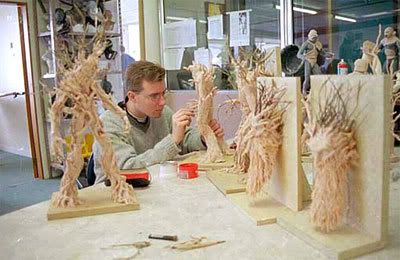
What is your fondest memory of working on the production of The Lord of the Rings?
I think just being a part of such a special project, feeling the momentum of the films taking shape and growing around us, sharing the wonder and excitement that we all felt in being part of something that everyone knew was special and unique- those things are what have stayed with me since. I have never worked on anything quite like The Lord of the Rings since then and may never again, so I will always cherish those days.
What kind of projects would you like to do in the future, that you have not yet been able to do?
It is hard to top The Lord of the Rings. I am a huge fan of the Star Wars universe and count the original three as much of the reason I am doing what I do today. To one day be paid to run around and design in a galaxy far, far away would be a dream.
I have also always loved the works of Jim Henson. I hope one day to be able to work on something as rich and wonderful as many of his personal projects were. The Dark Crystal and Labyrinth are astonishing pieces of cinema art and I would love to be part of creating something like them again in the future.
I have my own personal projects that play to some of those aspirations too. Working in someone else’s world can be exhilarating and rewarding, but I always hoped to one day bring my own imagined worlds to the screen and share them with others. Hopefully that will come to pass one day as well.
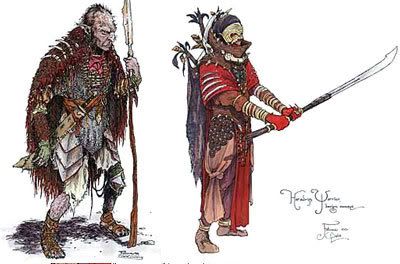
You did a lot of design work for The Lord of the Rings. What were the favorite things you designed? And did Peter Jackson have a lot of influence in your work, or did he let you go on your own way?
My favorite times designing were undoubtedly those times when I was working on the Elves or Ents, because both came most easily to me and were based in shapes and styles that I enjoy creating.
When designing for a film adaptation of a book, as I have now learned, there is always a delicate balance of expectations and influences to manage. A film borne solely out of the imagination of one person who has written the script and will drive it through production is perhaps a more straight forward task, though not necessarily easier. A book that is becoming a film brings with it many more challenges in terms of the marrying of different ideas and interpretations by all its many contributors. The director obviously has an influence and Peter had his own ideas that he wished to see expressed. Alongside those however, there are one’s own ideas that one carries from having read the books already and imagined that world independently. The expectations and conceptions of the audience must also be considered, especially if the book is well read and popular, like The Lord of the Rings certainly was, and finally there is also the important task of interpreting and honoring the original intent of the author, as best one can without coloring it with one’s own ideas.
Managing all these sometimes conflicting visions is something the designer must do, though of course it is the director who has the final say. It is our job to inform him and present him with options that all make sense. Peter sometimes came to the table with a very clear idea of what he wanted, but just as often he would say, “Go nuts and cast your net wide. Draw extremes and push the boundaries of the brief. Break it and do crazy things. Let’s see it all and we’ll figure out from there what path we should take.”
In that way, he both informed our design work but also sought information from us, so it was a very open and free opportunity to present ideas.
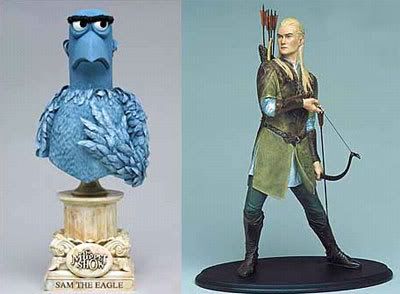
For The Lord of the Rings Weta Workshop made a lot of ‘Big’-atures. What do you think of them? Do you prefer them? Or would you rather use Digital Created worlds.
The best effects work is that which embraces the most appropriate qualities of all and any techniques, which is to say, whatever gets the job done best is the best technique to use. That seems obvious, but in an age of digital film-making, sometimes odd choices are made due to preconceptions and favorite processes taking precedence. On The Lord of the Rings, all disciplines were called upon and considered equally, so I think the best result possible was achieved. To create vast cities and castles, a combination of live action photography of actors on sets, blue screen work, highly detailed miniature models and digital environments and characters were all used. The result is a greater level of believability and texture than could have been achieved with only one or two of those techniques.
Back to the main page
All pictures and introduction are copyright © Weta. No copyright infringement in these pages is intended.
Geen opmerkingen:
Een reactie posten